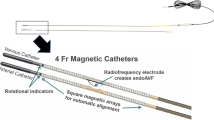Abstract
The purpose of this paper is to describe a unique “eighth note” deformity of the autogenous radiocephalic fistula for hemodialysis and to retrospectively evaluate the efficacy and safety of its endovascular treatment. Over 3 years, a total of 808 patients and 558 autogenous radiocephalic fistulas were treated for vascular access dysfunction or thrombosis. These included 14 fistulas in 14 patients (9 men, 5 women; mean age, 58.2 ± 2.8 years; range 27–79 years) whose fistulograms before treatment resembled a musical note, the eighth note. Endovascular treatment sought to remodel the deformed vascular access to a classic radiocephalic fistula and increase the number of cannulation sites available for hemodialysis. The technical and clinical success rates were each 92.8% (13/14). Fistula remodeling was successful in 13 patients. The postintervention primary patency was 100% at 90 days, 91.7 ± 0.8% at 120 days, 78.6 ± 13.9% at 180 days, 62.9 ± 17.9% at 360 days, 31.4 ± 24.0% at 540 days, and 0% at 720 days. The postintervention secondary patency was 100% at 90 days, 100% at 120 days, 100% at 180 days, 85.7 ± 13.2% at 360 days, and 85.7 ± 13.2% at 720 days. No major complications were noted. Minor complications were found in 71.4% of patients, all of which resolved spontaneously. In conclusion, endovascular treatment of fistulas with the eighth note deformity can effectively increase the number of available cannulation sites, facilitate fistula maturation, and facilitate thromboaspiration after fistula thrombosis.



Similar content being viewed by others
References
Gray RJ, Sacks D, Martin LG, Trerotola SO (2003) Reporting standards for percutaneous interventions in dialysis access. J Vasc Interv Radiol 14(9; Pt 2):S433–S442
Sacks D, Marinelli DL, Martin LG, Spies JB (2003) Reporting standards for clinical evaluation of new peripheral arterial revascularization devices. J Vasc Interv Radiol 14(9; Pt 2):S395–S404
NKF-DOQI (1997) NKF-DOQI clinical practice guidelines for vascular access. National Kidney Foundation-Dialysis Outcomes Quality Initiative. Am J Kidney Dis 30(4; Suppl 3):S150–S191
Rodriguez JA, Armadans L, Ferrer E et al (2000) The function of permanent vascular access. Nephrol Dial Transplant 15(3):402–408
NKF-K/DOQI clinical practice guidelines for vascular access: updates 2006. http://www.kidney.org/professionals/KDOQI/guideline_upHD_PD_VA/va_guide2.htm
Beathard GA, Settle SM, Shields MW (1999) Salvage of the nonfunctioning arteriovenous fistula. Am J Kidney Dis 33(5):910–916
Faiyaz R, Abreo K, Zaman F, Pervez A, Zibari G, Work J (2002) Salvage of poorly developed arteriovenous fistulae with percutaneous ligation of accessory veins. Am J Kidney Dis 39(4):824–827
Papaioannou TG, Stefanadis C (2005) Vascular wall shear stress: basic principles and methods. Hellenic J Cardiol 46(1):9–15
Asif A, Roy-Chaudhury P, Beathard GA (2006) Early arteriovenous fistula failure: a logical proposal for when and how to intervene. Clin J Am Soc Nephrol 1(2):332–339
NKF-K/DOQI (2000) III. NKF-K/DOQI clinical practice guidelines for vascular access: update. Am J Kidney Dis 37(1; Suppl 1):S137–S181
Falk A (2006) Maintenance and salvage of arteriovenous fistulas. J Vasc Interv Radiol 17(5):807–813
Nassar GM, Nguyen B, Rhee E, Achkar K (2006) Endovascular treatment of the “failing to mature” arteriovenous fistula. Clin J Am Soc Nephrol 1(2):275–280
Turmel-Rodrigues L, Pengloan J, Rodrigue H et al (2000) Treatment of failed native arteriovenous fistulae for hemodialysis by interventional radiology. Kidney Int 57(3):1124–1140
Clark TW, Cohen RA, Kwak A et al (2007) Salvage of nonmaturing native fistulas by using angioplasty. Radiology 242(1):286–292
Shin SW, Do YS, Choo SW, Lieu WC, Choo IW (2005) Salvage of immature arteriovenous fistulas with percutaneous transluminal angioplasty. CardioVasc Interv Radiol 28(4):434–438
Gibson KD, Gillen DL, Caps MT, Kohler TR, Sherrard DJ, Stehman-Breen CO (2001) Vascular access survival and incidence of revisions: a comparison of prosthetic grafts, simple autogenous fistulas, and venous transposition fistulas from the United States Renal Data System Dialysis Morbidity and Mortality Study. J Vasc Surg 34(4):694–700
Acknowledgment
The authors thank Miss Yi-Wen Wu, the executive secretary of VAT, for her assistance in providing clinical follow-up for this study.
Author information
Authors and Affiliations
Corresponding author
Rights and permissions
About this article
Cite this article
Weng, MJ., Chen, M.CY., Chi, WC. et al. Endovascular Treatment of Autogenous Radiocephalic Fistulas with the “Eighth Note” Deformity for Hemodialysis. Cardiovasc Intervent Radiol 33, 67–73 (2010). https://doi.org/10.1007/s00270-009-9639-y
Received:
Revised:
Accepted:
Published:
Issue Date:
DOI: https://doi.org/10.1007/s00270-009-9639-y




